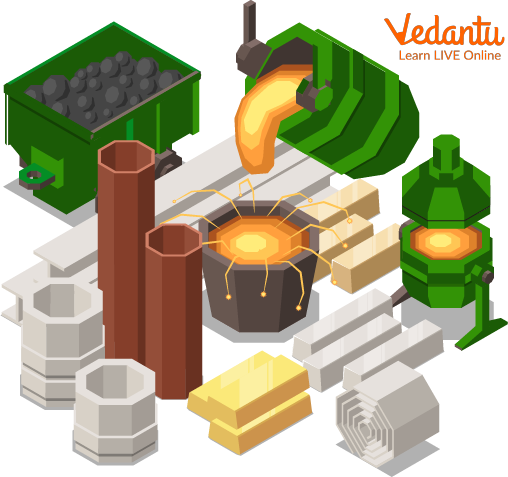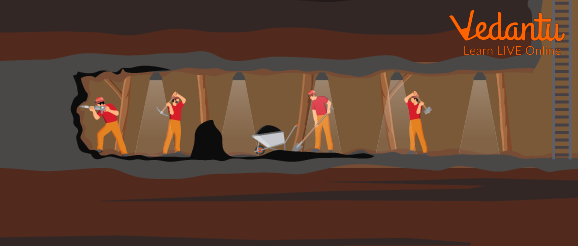




How Are Ores Classified and What Makes Them Valuable?
Metals occur naturally on earth, but when we give this a deeper thought, metals are found below the earth, hidden in special rocks which are called ores. Metals such as iron, copper, and tin have to be extracted from their ores.
Generally, pure metals are weak in structure, they cannot directly be used in industry. Metals are mixed with other metals, which are then called alloys. For example, tin breaks easily, while lead is a soft metal. However, together, tin and lead make a very tough and strong alloy which is called pewter.
Only a few metals occur naturally in their pure state. Most metals are locked up within minerals and rocks known as ores. Metals are extracted from their ores by heating the ores or by passing an electric current through the ores.
What are the Types of Ores?
Different kinds of ores are found in nature. The four primary types of ores are halide ores, carbonate ores, sulphide ores, and oxide ores.
Bauxite is an oxide ore, and aluminium is extracted from it.
Rock salt is a halide ore, limestone is a carbonate ore, and cinnabar is a sulphide ore.
Sodium is extracted from rock salt, calcium from limestone, and mercury is extracted from cinnabar.
Metallurgy

Metallurgy
Metallurgy is a field of science that deals with the extraction of metals from their ores which naturally occur in nature. The electronic devices and their batteries are composed of several metals which are present in the components and circuitry of the devices.
Types of ores are classified based on how the ores are formed. Some ores form due to the crystallisation and cooling of minerals in lavas or magmas. These are called volcanic or magmatic ores.
Copper, iron, and nickel ores are usually formed from volcanic deposits. Carbonate alkaline ores are formed due to igneous processes other than volcanic activity. Some diamonds and other rare earth element ores are a part of the carbonate alkaline groups.
As one can imagine, if ores can be formed as a result of volcanic processes, then ores can also be formed due to sedimentary or metamorphic processes. Sedimentary ore deposits contain platinum, gold, diamond-containing ores, and also zinc and tin that are found in sedimentary environments.
Some metamorphic ores comprise iron oxides, silver, and lead. Ores are also formed due to hydrothermal processes. These include exposure of minerals and rocks to extremely hot water, generally near hot springs or oceanic hydrothermal vents. A majority of the world’s uranium ores and gold ores are formed due to hydrothermal processes.
Mining - Uses of Ores

Mining
The process of extracting metal ores found deep within the earth is known as mining. These metal ores are found inside the earth’s crust in varying quantities. It is only because metals are extracted from ores that mankind has progressed so far.
Important Metals and Important Ores - List
Conclusion
Ores are deposits of one or more precious metals that are found in the earth’s crust. The important ore deposits are iron, silver, and copper. These metals are very essential for trade and are utilised by various industries. For example, copper, which is an excellent electricity conductor, is used in electrical wiring.
FAQs on Common Ore Examples, Types, and Their Uses
1. What is an ore, and how does it differ from a mineral?
A mineral is a naturally occurring inorganic substance with a definite chemical composition. An ore, on the other hand, is a specific type of mineral from which a metal can be extracted profitably and conveniently. The key difference is economic viability; while many minerals may contain a metal, only those with a high enough concentration to make extraction worthwhile are called ores. Therefore, all ores are minerals, but not all minerals are ores.
2. What are some common ore examples and the metals extracted from them?
Many metals we use daily are extracted from specific ores. Here are some common examples:
- Bauxite (Al₂O₃·2H₂O) is the primary ore of Aluminium.
- Haematite (Fe₂O₃) is a major ore of Iron.
- Galena (PbS) is the main ore of Lead.
- Cinnabar (HgS) is the ore from which Mercury is extracted.
- Chalcopyrite (CuFeS₂) is an important ore of Copper.
- Sphalerite (ZnS) is the primary ore of Zinc.
3. What are the main types of ores based on their chemical nature?
Ores are generally classified into four main types based on their chemical composition:
- Oxide Ores: These ores contain metals combined with oxygen. Examples include Bauxite (for aluminium) and Haematite (for iron).
- Sulphide Ores: In these ores, metals are bonded with sulphur. Examples are Galena (for lead) and Cinnabar (for mercury).
- Carbonate Ores: These are ores containing metal carbonates. Examples include Calamine (ZnCO₃, for zinc) and Siderite (FeCO₃, for iron).
- Halide Ores: These ores contain metal halides (compounds with chlorine, fluorine, etc.). An example is Rock Salt (NaCl, for sodium).
4. How are metals extracted from their ores? Can you explain the main steps?
The scientific and technological process of extracting metals from their ores is called metallurgy. It typically involves three major steps:
- Concentration of the Ore: This is the initial step where unwanted impurities (gangue) are removed from the ore. Methods like hydraulic washing, magnetic separation, or froth flotation are used depending on the ore's properties.
- Isolation of the Metal from the Concentrated Ore: The concentrated ore is converted into a form suitable for reduction, usually a metal oxide. This is done by processes like calcination or roasting. The metal oxide is then reduced to the metal.
- Refining or Purification of the Metal: The metal obtained after reduction is often impure. Refining processes like electrolytic refining are used to obtain a high-purity metal.
5. Why can't all metals be extracted from their ores using the same method?
The method of extraction is chosen based on the chemical reactivity of the metal, which is determined by its position in the reactivity series.
- High-reactivity metals (like potassium, sodium, aluminium) are very stable and require a powerful method like electrolysis of their molten ores.
- Medium-reactivity metals (like zinc, iron, lead) are less reactive and can be extracted by reduction using a reducing agent like carbon (coke).
- Low-reactivity metals (like gold, silver, mercury) are the least reactive and can often be extracted by simple heating or are sometimes found in their pure, native state.
6. How are common ore examples connected to items in our everyday life?
The metals extracted from ores are fundamental to our modern world. For example, iron from haematite ore is used to make steel for construction, cars, and appliances. Aluminium from bauxite ore is used in drink cans, kitchen foil, and aircraft parts. Copper, often from chalcopyrite, is essential for all electrical wiring in our homes and electronics. Lead from galena is used in car batteries.
7. What is the difference between calcination and roasting in metallurgy?
Both calcination and roasting are heating processes used to convert concentrated ores into metal oxides, but they differ in the presence of air. Calcination involves heating the ore strongly in a limited supply or absence of air, and it is typically used for carbonate ores. Roasting involves heating the ore (usually sulphide ores) strongly in the presence of excess air. The primary goal for both is to create a metal oxide, which is easier to reduce to the pure metal.





















